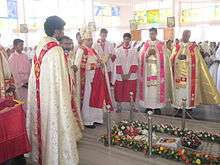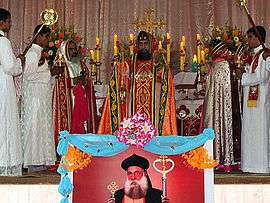Holy Qurbana
The Holy Qurbana or Holy Qurbono (ܩܘܪܒܢܐ ܩܕܝܫܐ Qurbānā Qadišā in Eastern Syriac, pronounced Qurbono Qadisho in Western Syriac, the "Holy Offering" or "Holy Sacrifice" in English), refers to the Eucharist as celebrated in Syriac Christianity. This includes various Oriental Orthodox and Eastern Catholic churches. Syriac Christianity consists of two liturgical rites, the East Syriac Rite (also known as the Assyrian Rite, Chaldean Rite or Persian Rite) and the West Syriac Rite (also known as the Antiochian Rite). The main Anaphora of the East Syriac tradition is the Holy Qurbana of Saints Addai and Mari, while that of the West Syriac tradition is the Divine Liturgy of Saint James.

| Part of a series on |
| Eastern Christianity |
|---|
 |
|
Main communions
|
|
Eastern liturgical rites |
|
Other topics
|
|
| Part of a series on |
| Oriental Orthodoxy |
|---|
 |
| Oriental Orthodox churches |
|
Subdivisions
|
|
History and theology
|
|
Major figures
|
|
|
| Part of a series on |
| Particular churches sui iuris of the Catholic Church |
|---|
Latin cross and Byzantine Patriarchal cross |
| Particular churches are grouped by rite. |
| Alexandrian Rite |
| Armenian Rite |
| Byzantine Rite |
| East Syriac Rite |
| Latin liturgical rites |
| West Syriac Rite |
|
|
The churches are primarily based in the Middle East, Africa, and India. The East Syriac Rite is used in the Syro-Malabar Catholic Church based in India, the Chaldean Catholic Church based in Iraq, and in the Assyrian Church of the East based in Iraq (including its archdiocese the Chaldean Syrian Church of India). The Assyrian Church of the East is not in official communion with the Orthodox churches, and they are not a part of the Eastern Catholic churches.
The West Syriac Rite is used in the Syriac Orthodox Church based in Syria, the Maronite Catholic Church based in Lebanon, the Syriac Catholic Church based in Lebanon, the Jacobite Syrian Christian Church based in India (an archbishopric of the Syriac Orthodox Church), the Malankara Orthodox Syrian Church based in India, and the Syro-Malankara Catholic Church based in India. A Reformed variant of the West Syriac Rite is used in the Mar Thoma Syrian Church based in India, but they are not in official communion with Oriental Orthodoxy, and they are not a part of the Eastern Catholic churches.
History
The East Syriac word Qurbana and the West Syriac word Qurbono are derived from the Aramaic term Qurbana (ܩܘܪܒܢܐ). When the Temple stood in Jerusalem, and sacrifices were offered, "Qorban" was a technical Hebrew term for some of the offerings that were brought there. It comes from a Hebrew root, "Qarab", meaning "to draw close or 'near'". A required Korban was offered morning and evening daily and on holidays (at certain times, additional 'korbanot' were offered), in addition to which individuals could bring an optional personal Korban.
The Holy Qurbana is referred to as "complete" worship, since it is performed for the benefit of all members of the Church. The other sacraments are celebrated for individual members. Thus the Holy Qurbana is believed to be the sacrament that completes all the others. Hence it is called the "sacrament of perfection" or the "queen of sacraments".
East Syriac traditions
The East Syriac or Chaldean rite was associated with the historical Church of the East, centered in the Persian capital of Seleucia-Ctesiphon. Today the Liturgy of Addai and Mari is used in the Ancient Church of the East, the Assyrian Church of the East, the Chaldean Catholic Church, as well as the Syro-Malabar Catholic Church and the Chaldean Syrian Church based in Kerala, India.
Liturgy of Addai and Mari
The Liturgy belongs to the East Syriac Rite, the anaphora or Eucharistic Prayer that is part of this liturgy, possibly dating back to 3rd-century Edessa,[1] even if the outline of the current form can be traced as far back only as the time of the Patriarch Mar Isho-Yab III in the 7th century. This liturgy is traditionally attributed to Saint Addai (disciple of Saint Thomas the Apostle) and Saint Mari (a disciple of Saint Addai). In the form given in the oldest manuscripts, all of the High Middle Ages, this anaphora does not include the Words of Institution, a matter that raised ecumenical concerns.
West Syriac traditions

West Syriac liturgical rite is developed out of the ancient Antiochene Rite of the Patriarchate of Antioch, adapting the old Greek liturgy into Syriac, the language of the Syrian countryside.
West Syriac liturgies represent one of the major strains in Syriac Christianity, the other being the East Syriac Rite, the liturgy of the Church of the East and its descendants. Distinct West Syriac liturgies developed following the Council of Chalcedon, which largely divided the Christian community in Antioch into Melkites, who supported the Emperor and the Council and adopted the Byzantine Rite, and the non-Chalcedonians, who rejected the council and developed an independent liturgy – the West Syriac Rite. An independent West Syriac community that grew around the monastery of Saint Maron eventually developed into the Maronite Church. A variant of the West Syriac Rite, the Malankara Rite, developed in the ancient Malankara Church of India and is still used in its descendant churches. They are the Jacobite Syrian Christian Church, the Syro-Malankara Catholic Church, the Malankara Orthodox Syrian Church, the Malankara Mar Thoma Syrian Church, and the Malabar Independent Syrian Church.
Liturgy of St James
The Liturgy is based on the traditions of the ancient rite of the Early Christian Church of Jerusalem, as the Mystagogic Catecheses of St Cyril of Jerusalem imply. The Liturgy is associated with the name of James the Just, the "brother" of Jesus and patriarch among the Jewish Christians at Jerusalem. Saint James was martyred at the hands of a mob incensed at his preaching about Jesus and his "transgression of the Law" - an accusation made by the Jewish High Priest of the time, Hanan ben Hanan. Among the Eastern liturgies, the Liturgy of Saint James is one of the Antiochene group of liturgies, those ascribed to Saint James, to Saint Basil, and to Saint John Chrysostom.
The Liturgy of Saint James is considered to be the oldest surviving liturgy developed for general use in the Church. Its date of composition is still disputed with some authorities proposing an early date, perhaps ca. AD 60, close to the time of composition of Saint Paul's Epistle to the Romans, while most authorities propose a fourth-century date for the known form, because the anaphora seems to have been developed from an ancient Egyptian form of the Basilean anaphoric family united with the anaphora described in The Catechisms of St. Cyril of Jerusalem.[2]
See also
References
- Addai and Mari, Liturgy of. Cross, F. L., ed. The Oxford Dictionary of the Christian Church. Oxford University Press. 2005
- John Witvliet The Anaphora of St. James in ed. F. Bradshaw Essays on Early Eastern Eucharistic Prayers, 1997